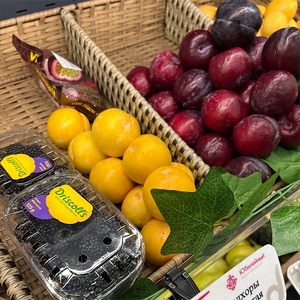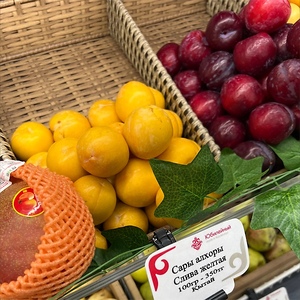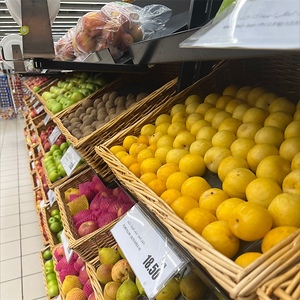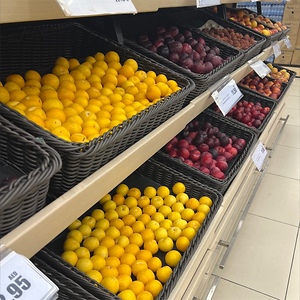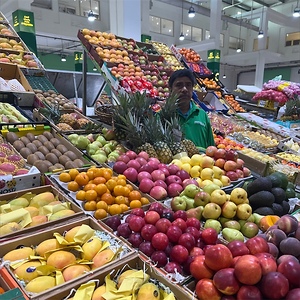


South African Yellow Plums
Estimated Inventory, lb : 0
Description/Taste
South African Yellow plums vary in size, shape, and flavor, depending on the variety, and generally average 3 to 7 centimeters in diameter. The fruits range in shape from round, oval, to conical, sometimes with a tapered point on one end, and reach around 80 grams in weight. South African Yellow plums can be found in shades of golden yellow, pale yellow, and yellow-green, and the skin is typically smooth, taut, and thin. Some varieties may be covered in a powdery to waxy bloom. This bloom can be easily removed by polishing or wiping the surface. Yellow plums can also develop a faint red blush on sides exposed to ample amounts of sunlight. Underneath the surface, the yellow flesh is aqueous, firm, crisp, and succulent, often softening as it matures. The flesh also encases a central stone that should be discarded during consumption. South African Yellow plums are edible raw and are eaten when ripe. Depending on the variety, the plums have a sweet-tart, tangy, fruity, and sometimes sugary flavor.
Seasons/Availability
South African Yellow plums are harvested from November through March. Each specific variety will have different ripening windows within this timeframe.
Current Facts
South African Yellow plums, botanically a part of the Prunus genus, are a general category of plum varieties grown in South Africa, belonging to the Rosaceae family. Several cultivars of yellow plums are commercially produced throughout South Africa for fresh consumption, and these fruits are mainly cultivated for export to international markets. Many of the yellow plum varieties grown in South Africa are of Asian descent, Prunus salicina, and the fruits are seasonally exported to markets in Europe, the United Kingdom, the Middle East, and East Asia. South African Yellow plums are hand-picked to protect their delicate skin, and consumers value the fruits for their sweet, juicy, and succulent nature. Common South African Yellow plum varieties include African Pride®, Sun Supreme®, Sun Kiss, Songold or Sun Gold, Sun Breeze, Anna, and Golden Japan plums. When in season, South African Yellow plums are sold as a delicacy and are utilized by consumers in a wide array of fresh or cooked culinary preparations and beverages.
Nutritional Value
South African Yellow plums vary in nutritional value, depending on the specific variety. Yellow plums, in general, are a source of calcium to build strong bones and teeth, vitamin C to boost the immune system, fiber to regulate the digestive tract, and vitamin E to protect the cells against free radical damage. Yellow plums also provide vitamin A to maintain healthy organ functioning, potassium to balance fluid levels within the body, phosphorus to repair cellular tissues, and other antioxidants to reduce inflammation and protect the body's overall health.
Applications
South African Yellow plums are generally sweet and suited for fresh and cooked preparations. When ripe, the fruits are popularly eaten out of hand, and the skin is edible. South African Yellow plums can be consumed like an apple, or the flesh can be sliced along the seam, twisting the fruit into two halves. It is important to note that the stone or pit in the center should not be eaten. The fruit’s flesh can be sliced and served in fruit medleys, placed on cheese boards, or sprinkled as an edible topping over yogurt, cottage cheese, and other breakfast dishes. Yellow plums can also be thinly sliced and served on crostini or as a pizza topping. In addition to sliced preparations, South African Yellow plums are blended and frozen into sorbets, ice cream, smoothies, and shakes. They are also cooked into jams, compotes, sauces, and chutney as a spread for toast, sandwiches, and as a condiment. Beyond preserves, South African Yellow plums can be used in any preparation calling for yellow plums. The fruits can be baked, stewed, or roasted, often incorporated into tarts, cakes, crumbles, clafoutis, and galettes. They can also be used in savory dishes such as stir-fries, stews, and roasted meats. Try cooking yellow plums into fruit leather as a snack with extended storage capabilities. South African Yellow plums pair well with spices such as star anise, cinnamon, cardamom, nutmeg, and coriander, vanilla extract, nuts including pistachios, walnuts, and almonds, and meats such as lamb, pork, beef, and poultry. Whole, unwashed South African Yellow plums should be ripened at room temperature. Once ready to eat, they should be immediately consumed for the best quality and flavor or stored in the refrigerator for 3 to 5 days. Yellow plums can also be halved, sealed in a container, and frozen for up to six months.
Ethnic/Cultural Info
Dutch colonial administrator Jan Van Riebeeck is credited with one of the first records of planting plums in South Africa. The Cape colony initially relied on rations that were shipped, creating shortages of food and challenges in daily life. In an effort to reduce food scarcity, seeds gathered from around the world were transported into the colony, and Van Riebeeck was in charge of constructing a food garden in the mid-17th century. Van Riebeeck kept journal entries documenting this process, and notable entries written in 1652 and 1653 mention that various fruits, vegetables, and grains were planted, including plum trees. Van Riebeeck was a part of the Dutch East India Company and sailed on several voyages to destinations worldwide. He visited the Cape of Good Hope on a voyage to the Netherlands and became an early advocate for establishing a colony for trade. In 1651, the Dutch East India Company placed Van Riebeeck in charge of the expedition to the Cape, and the crew arrived in 1652, only to begin constructing the gardens that same year. Van Riebeeck remained the colonial administrator of the Cape of Good Hope colony until 1662. In 1665, he was promoted and left the colony to serve in the Netherlands.
Geography/History
South African Yellow plums are descendants of plum varieties native to Asia, primarily belonging to the species Prunus salicina. The various Asian species were introduced to South Africa through the efforts of Dutch colonial administrator Jan Van Riebeeck in the mid-17th century and Harry Ernest Pickstone, a grower and nursery businessman. Van Riebeeck mentions plums being grown in South African colonies in his diary on October 11th, 1656, and in 1892, Pickstone arrived in the colonies near the Cape and promoted deciduous fruit tree cultivation using his past experiences of farming in California. Pickstone worked closely with Cecil Rhodes, Prime Minister of the Cape Colony from 1890 to 1896, and convinced growers to switch from grape production to deciduous fruit cultivation to help eradicate a phylloxera infestation. Pickstone established a nursery with Rhodes, known as the Pioneer Fruit Growing Company, and the duo purchased farms across the region for fruit cultivation. Their efforts were successful, and fruit cultivation in the colony flourished. Experts believe Pickstone introduced several Japanese plum varieties from California around 1896, and Pickstone became the father of the South African fruit industry. In addition to the introduced plums, one of the only plum cultivars to have originated in the Cape region was found near the homestead of W.L. Methley in Natal in 1907. Over time, the Agricultural Research Center, or ARC, was created in South Africa, and the program helped breed and produce plum varieties suitable to the South African climate. Today, South African Yellow plums thrive in sandy loam to deep, well-drained soils, and several varieties of yellow plums are cultivated commercially for fresh and cooked culinary uses. South African Yellow plums are mainly grown in the Western Cape and are produced in Vyeboom, Paarl, Villiersdorp, Wolseley, Ceres, Stellenbosch, Montagu, Tullbagh, Langkloof, and Franschhoek. Approximately 74% of the plums grown in South Africa are exported to Europe, the United Kingdom, the Middle East, Russia, and East Asia. Less than 20% are sold domestically in South African markets. The South African Yellow plums featured in the photograph above were sourced through the Waterfront Market in Dubai.



